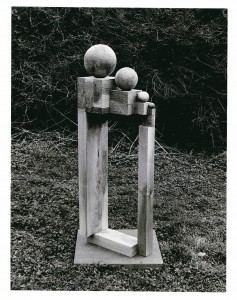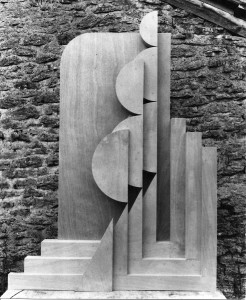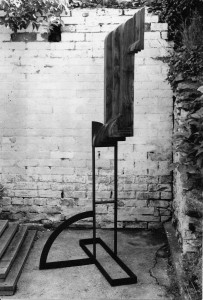It was in my ‘new studio’ at Pound Pill, in 1975/76 that I made the sculptures for a show at Angela Flowers. It was my first one at Portland Mews, off D’Arblay Street in Soho, a place with two rooms that was twice the size of Angela’s Lisle Street Gallery.
This was when sculptors working with steel were in evidence everywhere – carving wood, making sculpture with natural materials and using traditional techniques, were all out of fashion. I was rural rather than urban, as was Nick Pope, former student and now friend, whose first show at Tony Stokes’ gallery Garage, was around this time.
The D’Arblay Mews gallery had a sanded, stained and polished wooden floor with a very strong streaky grain, both light and dark brown. This was not a good surface for my quiet walnuts. The prevailing debate as to whether sculpture should sit on a plinth or on the floor was as ever in my mind. Almost all of these new works were meant to stand directly on to the floor, occupying our space, the space of the viewer.
Ivor Heal came to my rescue, he was then working at the V&A, with Carol Hogben (they bought a drawing from me – Seven Columns). Ivor was at the beginning of his long and distinguished career as an Exhibition Designer. From his employers and from the cellars of the V&A, we borrowed enough carpet tiles to cover the two spaces of the gallery. We worked all weekend to fit them.
I can’t say that covering the woody floor with hairy grey tiles was to the liking of the gallery owner, the new floor covering was a Monday morning surprise, but she did not ask me take it up. My sculpture was more at home against the grey floor and stood very well into the soft tiles.
That show, complete with a catalogue (that featured a short essay by William Packer), was a modest success. There was some Art Press coverage and unusually four works sold. It looked good, however, this showing was an example of the way that a number of works prioritised before the exhibition as the best or most important, by the artist and the dealer, can rearrange themselves as more or less significant sculptures, during installation and the run of the show.
I was still trying to invest my sculpture with ‘intelligence’, a hangover of Systems art and knowing Malcolm Hughes and Michael Kidner at Bath Academy. Using invented mathematical schemes to give the work import and order. I constructed several sculptures from thick planks of elm or walnut, they were only partly carved. The opportunity to invest these works with feeling was limited by this systematic process – I was trying to be too clever, such a rigorous discipline was not my forte. Nevertheless it should be said that as I was searching for my own voice – at least I was curious enough during this journey to explore different languages.
It was 4 Cubes and 4 Spheres that came out on top from that show, although low down on my original list. It is now in the Arts Council Collection, bought by Andrew Dempsey and exhibited at the Hayward in the exhibition Arts Council Collection. A smaller work was also a success Bending Oak, bought for the Contemporary Art Society by Peter Diamond and Nancy Balfour, exhibited at the Serpentine Gallery some years later and then donated to Salisbury Museum and Art Gallery.
Bending Oak is a most natural piece, as the green wood dried, the oak moved and the ‘mathematics’ of the work had to give way to the demands of nature. As the oak began to bend, a concerned Monte Little, Curator of the John Creasey Collection of Contemporary Art at Salisbury, swopped it for another of my sculptures, which I believe is called 7 Spheres.
My Angela Flowers show went on to Southampton Art Gallery, curated by Liz Ogborn, with the addition of earlier works. Good sculptures such as Heroine and Unique were included in the show. I have always underestimated Unique, I still cannot comprehend how I had arrived at that particular combination of wood and steel. My friends John and Gil Honeychurch bought Oak Relief, a circle, square and triangle construction from the Southampton show.
In case you’re wondering, after the exhibition at Angela Flowers, the carpet tiles were returned unharmed to the V&A.
In 2003 4 Cubes and 4 Spheres was exhibited again at the Longside Gallery, Yorkshire Sculpture Park, at an event called Sculpture in the Age of Aquarius – works from the Arts Council Collection, and comprised sculpture by Garth Evans, Ivor Abrahams, John Davies, Peter Hide, Tony Smart, Nick Pope, Katherine Gili and Michael Lyons. These are all artists better known in the 70s, but subsequently almost forgotten. The curator Jon Wood, of the Henry Moore Institute, called us the ‘lost generation’.


